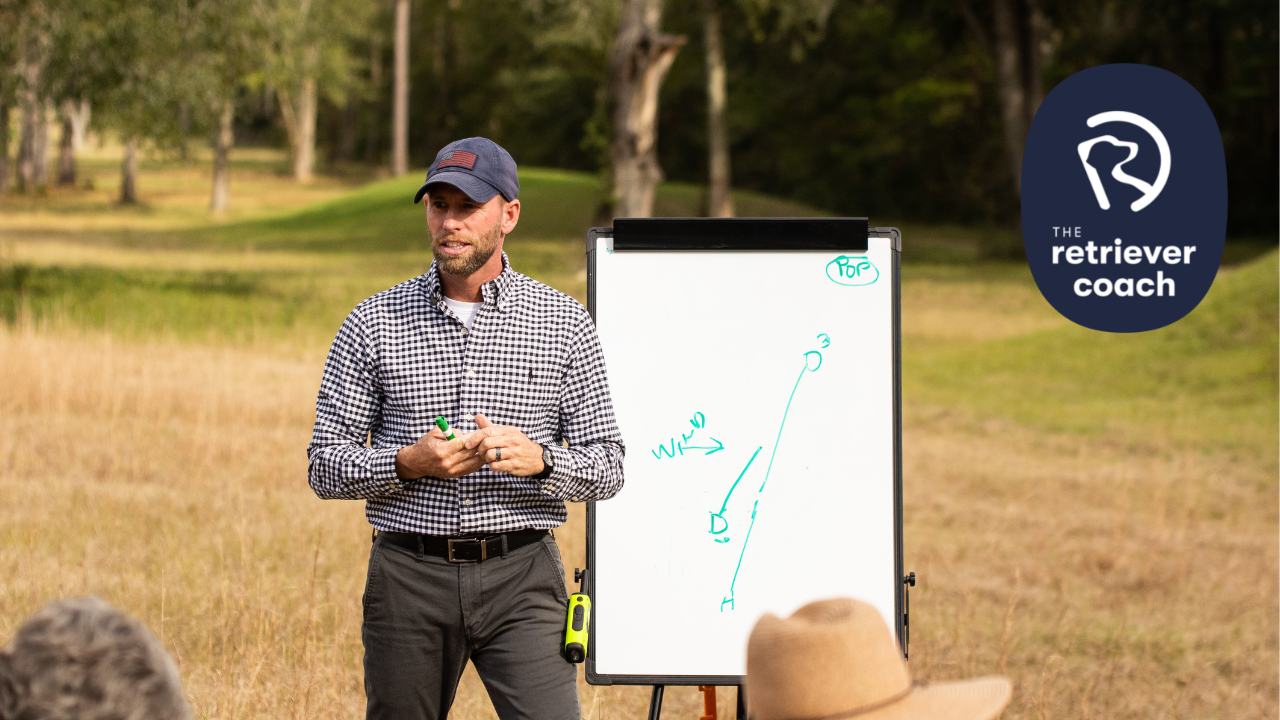Breaking Down The Complexities Of Handling

Casting a dog in the field is essentially a math exercise. That exercise involves asking yourself 5 questions, and their answers will determine the direction your dog heads in and the intensity of their momentum.
1- Do I need to use my voice?
-
Your job is to predict where your dog's momentum may decrease before you run the blind, so you can act preemptively. For example. If your dog is approaching an area that has bird scent, like a point that the judges have intentionally seeded with feathers, or the downwind side of a flyer station where feathers from shot birds may have drifted to, you should anticipate that there might be a sharp drop in your dog's momentum. This should lead you to using your voice with the cast as your dog approaches this area or once it enters it.
-
Be mindful of your dog's body language as they travel toward a retrieve. Are they lowering their nose to the ground? Is their tail set changing from steady and straight out behind them, to pointing a little more upward or waving like a flag? Are they looking sharply to the left and right? Is their speed of travel decreasing? Is their line of travel looking a little erratic? Are they overcasting laterally in both directions, also known as ping ponging? If you're reading any one of these signs, you should use your voice simultaneously with the cast to create momentum.
-
Finally, and pay close attention here, using your voice will always affect the direction your dog travels in. It does this by encouraging additional rotation when they're turning to take the cast. This is why we tend to refrain from using voice when we cast our dog into the wind. The wind already has the tendency to cause a dog to over-rotate, making it difficult to get lateral change in direction into the wind. If you use your voice in these situations, you will only make the problem worse.
2- Do I need to add a lateral micro-step?
-
There are times when poor lighting conditions, the distance between you and your dog is significant or you have backdrop that doesn't provide adequate contrast with yourself, makes it difficult for your dog to pick you out and see your casts. Under these circumstances, you should simultaneously add a lateral micro-step to the cast. This will help your dog distinguish you from the things around you, and pick up on the information you're delivering.
-
Adding a lateral micro-step to the cast will always affect the direction your dog travels in. You must anticipate this, and use it or don't use it to get your dog moving in the direction you desire. For example. If you're having difficulty getting your dog to take a cast away from a poison bird, consider adding a lateral micro-step to the cast to encourage lateral travel. And vice versa, if you need to give your dog a cast to tighten up to the poison bird, but are anticipating that the suction of the poison bird might cause to much lateral change in direction, refrain from adding the micro-step to the cast.
3- What should the angle of the cast be?
-
If there are no factors or elements affecting your dog's direction of travel, then the angle of the cast should be as precise as possible, matching the desired change in direction.
-
If there are factors, then you should make slight adjustments to the angle of the cast to compensate for their effects. For example, if you need to cast your dog to tighten them up to the shoreline on a water blind, and you anticipate that they're going to be drawn to land a little more than you'd like, consider decreasing the angle of the cast to get the desired change in direction
4- If I'm forced to follow one of the aforementioned guidelines, yet it adversely affects the direction my dog heads in, what adjustments can I make in the other areas to get the desired outcome?
-
For example, if your dog's momentum breaks down on a scented point, you have no choice but to add voice to the cast to get your dog moving again. The downside here is the additional rotation caused by using your voice. This often leads to a digback or a scallop, and losing your dog behind the point. In order to mitigate the negative side effect of voice, you can add a lateral step, increase the angle of the cast, or both to encourage less rotation and more lateral change in the direction of the cast.
5- Based on my dog's reaction to the previous cast, should I make an adjustment to the information I give with the next cast in the same direction?
-
If your dog didn't respond appropriately to the information you gave with the previous cast in the direction you're about to cast in again, you should consider adjusting the information to get the desired response. You may need to change the angle of the cast, add or omit a lateral step, use your voice or stay silent if possible.
Casting your dog can be complex. It requires careful, calculated thought and execution. My best advice is to create habits that will lead you in the right direction. Practice slowing down once your dog is stopped, and diligently work to maintain the standard. By doing so, you'll both become comfortable with the pace, and you'll have plenty of time to ask yourself these very important questions. Always analyze the blind before you run to identify scented areas, old falls and factors that are likely to affect your dog. Having foresight and a plan of attack will lead to fewer mistakes, fewer whistles, a lighter workload, less anxiety, and a better outcome.
Kevin Cheff - The Retriever Coach

